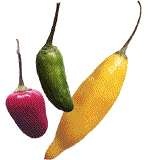 Photodisc
A taste of the spice of life in Miami's Little Havana
Photodisc
A taste of the spice of life in Miami's Little Havana
On a 90-degree Miami day, you can find the true meaning of cool in Little Havana. In contrast with the fast-paced glitz of South Beach, the serene luxe of Coral Gables, and the funky mellowness of Coconut Grove, Little Havana is the real Miami— a part of town where people live year-round, unaffected by vacationers. It's where I learned to face the sun wearing a crisp, white linen guayabera. The best way to beat the heat is never even to acknowledge it.
Little Havana is a place of melancholy and romance, fueled by memory and the desire to reconstruct a lost way of life. As early as 1896 a few Cuban families lived in this area (known then as Riverside) bordering the Miami River, but the neighborhood really took off in 1959, when some 35,000 Cubans immigrated to Miami, sent packing by the loathed Castro.
At Domino Park, on Calle Ocho (the neighborhood's main thoroughfare), men from Cuba and other parts of Latin America play dominoes, chess, and cards and reminisce about "the old country." A sad bolero comes from a tiny tape player in the background. I could tell it was really hot— or was it just the intensity of the game?— when I saw a dark, smooth-faced man with wavy white hair lift a handkerchief from his shirt pocket to gently mop his brow.
Simple, compact frame houses, many dating from the early part of the century, stand next to bungalows made of ancient gray coral rock. Painted beige, peach, or off-white, they're not nearly as colorful as you'd expect in this Caribbeanesque town. Warm breezes send screen doors creaking; in tidy back yards, clothes hang limp on the lines, resigned to the punishment they take from the sun. The newer houses are mainly in the Spanish style that dominates Coral Gables, with terraces and terra-cotta roofs.
On a typical weekend, Little Havana's streets, lined with cafeterias, dulcerías, and botánicas (stores selling ritual Santeria objects), bustle with activity. At first sight the setting seems typically urban, but not American urban. Moving slowly and rhythmically— as if manipulated by the music constantly pouring from car windows and open shop doors— vendors from Cuba, Nicaragua, and Peru sell flowers and food. Mothers and children stand bargaining; couples saunter in and out of shops; and spindly, tan men lounge around cafeteria windows drinking coffee in the sweltering heat. Splashy displays of religious articles brighten sun-bleached storefronts. There are botánicas named for saints I never learned about in Catholic school.
On the street, I smelled cigars and carne asada (roasted meat), served with salad, tortillas, beans, and rice from a lunch cart known as a fritanga. Run mainly by Nicaraguans, fritangas are worth stopping at for such unusual dishes as nacatamal (a tamale wrapped in a banana leaf and stuffed with a mixture of rice, pork, potatoes, prunes, and green olives) and delicious baho (a meat-and-vegetable stew).
The cafeterias along Calle Ocho are more or less interchangeable. Each has a sidewalk service window, from which you can order a café cubano, a strong espresso served in a shot-glass-size paper cup. For something colder, try fresh orange juice, light and cool guarapo (a sticky liquid extracted from sugarcane stalks), or soothing, frothy cocofrío, so rich it's hard to believe it's just coconut milk. In one cafeteria, the lunch counter was occupied by two people talking passionately about politics with the waitress, while a portable fan buzzed from a corner and a radio played a hopping Dominican merengue.
"Sweets are good for you," insisted the cashier at El Brazo Fuerte, a dulcería and bakery run by the same family for nearly 15 years. Here almost everything is drenched in syrup, powdered with sugar crystals, coated in caramel, or piled high with meringue. What will you have?There are small yellow capucinos, cone-shaped sponge cakes soaked in a sugary liquid called almibar; señoritas, a sort of custard napoleon; masareales, intensely sweet guava pastries; and pastelitos, dough stuffed with meat, guava, or cream cheese.
At this point, you may find you've forgotten you're in Miami. It happened to me at one of the cafeterias: as my senses filled with savory flavors, tempting smells, frenetic music, and the insistent, melodious Spanish language, I was transported, if just for a moment, to Havana. Or maybe, when I was walking past a botánica, a Cuban spirit had possessed my soul.
MARTINE BURY is an assistant editor at Jane magazine